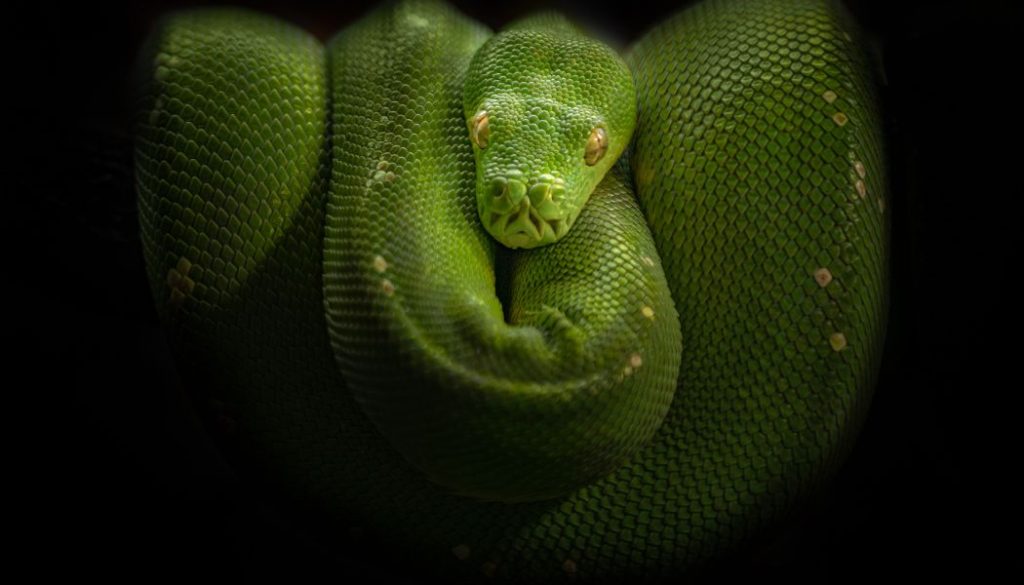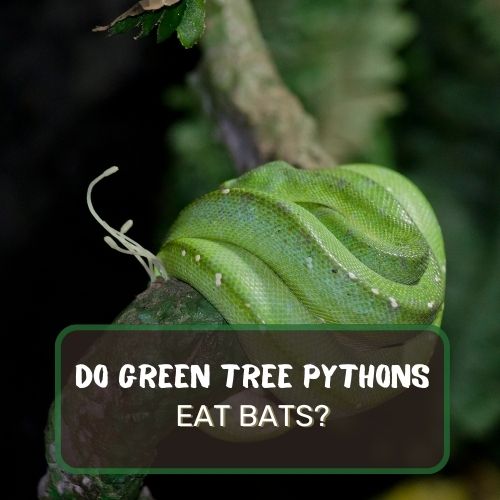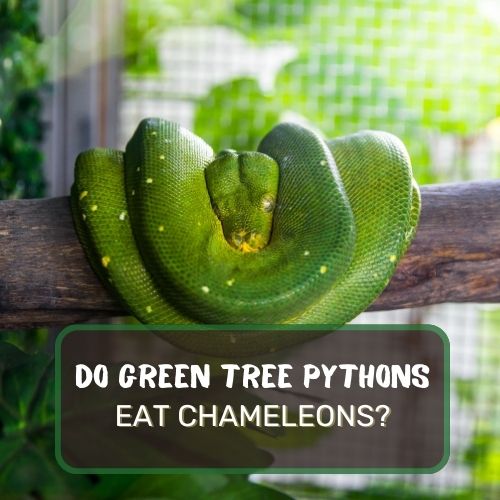Get ready to dive deep into the fascinating world of green tree pythons and their reproductive journey. Ever wondered, “Do green tree pythons lay eggs?” Well, wonder no more!
Yes, green tree pythons do lay eggs! They fall under the category of oviparous reptiles, meaning they reproduce by laying eggs rather than giving live birth. A female green tree python typically lays a clutch of 6 to 30 eggs, depending on her age and health.
After laying, she wraps herself around the eggs to incubate them. The incubation period lasts around 50 days, leading to the hatching of the baby pythons.
We’re unpacking everything from the types of reptile reproduction to the meticulous details of the egg-laying process.
We’ll even give you a glimpse into what happens after those eggs hatch and explore special care tips for captive pythons.
So whether you’re a reptile enthusiast or just plain curious, this article is your go-to guide for all things green tree python reproduction!

Table of Contents
Understanding Reptile Reproduction: Oviparous Vs Viviparous
Alright, before we dive into the nitty-gritty of whether green tree pythons lay eggs or not, let’s talk about reptile reproduction. You see, there are two main categories here: oviparous and viviparous.
Oviparous reptiles lay eggs, and viviparous reptiles give live birth. Mind-blowing, right?
Now, why is this important? Well, this distinction shapes everything from a reptile’s anatomy to their behavior.
And if you’re scratching your head wondering where green tree pythons fit into this, I’ve got you covered! Drumroll, please… Green tree pythons are oviparous, meaning they do lay eggs.
But here’s where it gets even more fascinating. Some species are ovoviviparous, a combo of the two! They technically have eggs, but these eggs hatch inside the mother, making it look like live birth when it’s actually a kind of mix.
But don’t get confused; green tree pythons stick to the more traditional route of laying eggs.
Oviparous reptiles, including our green tree pythons, have a whole bunch of fascinating behaviors and environmental needs centered around their egg-laying.
From the perfect nesting spots to the ideal temperature, there’s an art and a science to making sure those eggs turn into healthy baby pythons.
In the wild, green tree pythons look for humid and warm places to lay their eggs. And in captivity, if you’re looking to become a python parent, replicating these conditions is essential. It’s all about that cozy, humidified ambiance for the eggs!
The Egg-Laying Process in Detail
Now that we’ve covered the basics, let’s dig into the egg-laying process for green tree pythons in more detail. It all starts with mating. You won’t catch green tree pythons writing love letters or exchanging promise rings, but they do have their unique rituals.
For instance, the male will make subtle body movements and signals to attract a female. It’s like their version of flirting!
Once the connection is made, they mate, and then it’s a waiting game. The gestation period varies, but it’s generally around 50 days. That’s right, 50 days of eagerly anticipating those beautiful, leathery eggs.
During this period, the female will start to look for the perfect nesting spot. She’s picky, you know? It has to be humid but not too wet, warm but not scorching.
Finally, the day arrives. The female lays her eggs, and it’s like a little celebration in the reptile world. A typical clutch size ranges from 6 to 30 eggs, depending on the age and health of the mother.
And let’s talk about these eggs—they are oval, leathery, and white. No, you can’t make an omelet out of them, so don’t even think about it!
After laying the eggs, the mother wraps herself around them to incubate. Yep, she turns herself into a living, breathing incubator! She’ll occasionally shiver to generate heat, keeping those eggs at the perfect temperature. Now that’s dedication!
The incubation period lasts around 50 days, which means it’s a long wait for the hatchlings to finally make their appearance. But once they do, it’s a whole new adventure, both for the baby pythons and for anyone lucky enough to witness this miracle of life.
Incubation: How Long and What’s Involved?
Hold onto your seats, because the incubation process for green tree pythons is a jaw-dropping spectacle of maternal devotion and natural genius. As mentioned earlier, once the eggs are laid, Mama Python gets down to business by wrapping herself around her eggs like a warm, scaly blanket.
How long does this selfless act of love last? Approximately 50 days. Yep, for nearly two months, she’s glued to her eggs, making sure they’re at just the right temperature.
Speaking of temperature, the optimal range hovers around 86 to 88 degrees Fahrenheit. And it’s not just a game of heat; humidity plays a significant role too. We’re talking about a humidity level of around 95% to ensure those eggs don’t dry out.
You might be wondering, does the mother ever leave? Well, leaving the eggs unattended is a big no-no in the green tree python world. The mother occasionally “shivers” to generate additional heat, using her muscles in a way that might remind you of, well, shivering when you’re cold.
It’s this instinctive behavior that raises the temperature a notch to make sure the eggs are in a cozy environment.
What Happens After The Eggs Hatch?
So the big moment arrives, and the eggs finally hatch. What’s next on the agenda? First, let’s marvel at the baby pythons, who are mini versions of their parents but with a brighter, more vivid color palette.
They come out pretty much ready to face the world, although their first shed occurs within a week or two.
Mama Python, believe it or not, doesn’t stick around for too long after the eggs hatch. In the reptile world, parenting is often a short-term gig.
So these babies are sort of like teenagers right from the start—eager for independence and ready to explore their surroundings.
Survival is the name of the game, and these little tykes have to learn the ropes fast. They start by hanging out in low shrubs and gradually make their way to the towering trees as they grow.
And when it comes to food, it’s a bug’s life—literally! Their diet starts with small prey like lizards and insects, and as they grow, they move on to bigger catches.
Within a year, these hatchlings mature into young adults, ready to go through the egg-laying process themselves and continue the circle of life. It’s an awe-inspiring journey from egg to adult, showcasing the resilience and adaptability of green tree pythons.
From their first moments, they’re hardwired to survive and thrive, be it in the wild or in the comfort of a well-maintained terrarium.
Special Care for Captive Green Tree Pythons
Alright, say you’re not just a green tree python admirer from afar, but you’ve taken the plunge and actually got one (or more) as a pet. What then? Breeding these emerald beauties in captivity is an art and a science, and boy, does it come with its own set of rules.
First off, the environment is key. These pythons are picky, remember? Your terrarium has to mimic their natural habitat as closely as possible.
We’re talking about the right temperature and, you guessed it, the correct humidity level—about 95% during the egg-laying and incubation phases. Get yourself a reliable thermometer and hygrometer to keep track.
Nesting boxes are a must-have, providing a secluded spot for the female to lay her eggs. Fill it with damp sphagnum moss or a similar substrate to keep that humidity locked in. Think of it as a cozy little nursery for python eggs!
Another pro tip: minimize handling during the breeding season. The female needs her space to get into the “mom mode,” so it’s best to keep disturbances to a minimum.
But wait, what about food? Calcium supplements can be beneficial during the breeding season to ensure healthy egg development. You want strong, resilient eggs that will make it all the way through the incubation process.
Conclusion
You’ve journeyed through the captivating realm of green tree python reproduction, from the distinctions between oviparous and viviparous reptiles to the intricate details of egg-laying and incubation.
We even touched on caring for these magnificent creatures in captivity. Now you’re equipped with the knowledge to appreciate the marvelous lifecycle of these unique reptiles.
Whether you’re an aspiring herpetologist, a curious pet owner, or just an admirer of the natural world, the door is wide open for you to explore further. So go ahead, dig deeper, and celebrate the wonders of the animal kingdom!
FAQ
How often do green tree pythons lay eggs?
Great question! A healthy female usually lays eggs once a year. However, this can vary depending on her health and environmental conditions.
Where do green tree pythons lay their eggs?
In the wild, they look for warm, humid spots like leaf litter or under logs. In captivity, they prefer a secure nesting box filled with damp substrate.
How do green tree pythons give birth?
Well, they don’t give birth in the way mammals do. They lay eggs, remember? So, no baby pythons popping out fully formed. It’s all about those leathery, white eggs.
What time of year do pythons lay eggs?
In their natural habitat, green tree pythons usually lay eggs during the rainy season when conditions are optimal. In captivity, with controlled environments, the timing can be more flexible.




0 Comments